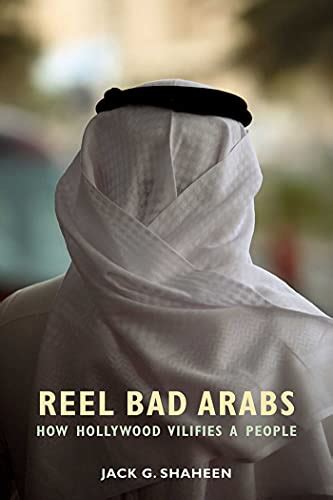Introduction

Jack G. Shaheen is an acclaimed author, researcher, and professor who has dedicated his life to exposing the pervasive negative stereotypes of Arabs in Hollywood films. His groundbreaking work has shed light on the damaging consequences of these representations and has sparked a much-needed dialogue on the importance of diversity and inclusion in the entertainment industry.
The Prevalence of Negative Stereotypes
Shaheen’s research has documented over 1,000 films since the early days of Hollywood that portray Arabs in predominantly negative ways. These stereotypes perpetuate harmful generalizations such as:
- Arabs as terrorists: Portrayed as violent, irrational, and extremist
- Arabs as misogynists: Controlling and oppressive towards women
- Arabs as oil-rich sheikhs: Wealthy, arrogant, and uncultured
- Arabs as foreigners: Exotic, inscrutable, and always ‘the other’
The Impact of Stereotypes
These stereotypes have far-reaching consequences, reinforcing prejudices and contributing to the marginalization of Arabs in society. They:
- Perpetuate negative attitudes towards Arabs by exposing audiences to a skewed portrayal
- Foster mistrust and fear by depicting Arabs as potential threats
- Limit opportunities for Arabs in media and entertainment by perpetuating a narrow and biased representation
The Costs of Negative Representation
The negative portrayal of Arabs in Hollywood films has tangible costs:
- Censorship: Filmmakers often self-censor to avoid backlash from anti-Arab groups
- Exclusion: Arab actors and filmmakers are often denied opportunities or relegated to stereotypical roles
- Lost revenue: Films with positive Arab representations often struggle to gain traction in the industry
Shaheen’s Contributions
Jack G. Shaheen’s work has played a pivotal role in raising awareness about the harmful effects of these stereotypes. His books, such as “Reel Bad Arabs” and “Arab and Muslim Stereotyping in American Popular Culture,” have become seminal works on the subject. He has also testified before Congress, consulted with filmmakers, and lectured at universities worldwide.
The Search for Solutions
Shaheen believes that the key to combating these stereotypes lies in creating more positive and complex representations of Arabs in media. He calls for:
- Inclusive storylines: Developing characters and narratives that challenge stereotypes and highlight the diversity within Arab communities
- Collaboration: Engaging with Arab filmmakers, actors, and writers to ensure authenticity and cultural sensitivity
- Education: Raising awareness among audiences about the harmful effects of negative stereotypes
Common Mistakes to Avoid
When portraying Arabs in Hollywood films, it is crucial to avoid the following mistakes:
- The White Savior Complex: Depicting Arabs as passive or helpless individuals who rely on Westerners to save them
- Oversimplification: Reducing Arab characters to one-dimensional caricatures without exploring their motivations or complex identities
- Lack of Dialogue: Failing to give Arab characters meaningful dialogue or storylines that allow them to speak for themselves
Towards a More Inclusive Hollywood
Jack G. Shaheen’s legacy is one of advocacy and resistance. His work has laid the groundwork for a more inclusive Hollywood, where Arabs are no longer defined by harmful stereotypes but portrayed with dignity and respect. By embracing diversity and challenging biases, the entertainment industry can contribute to a society that is more just, equitable, and understanding.
Tables
Table 1: Prevalence of Negative Arab Stereotypes in Hollywood Films
| Stereotype | Number of Films |
|---|---|
| Arabs as terrorists | 321 |
| Arabs as misogynists | 173 |
| Arabs as oil-rich sheikhs | 152 |
| Arabs as foreigners | 149 |
Table 2: Impact of Negative Stereotypes on Arabs
| Impact | Effect |
|---|---|
| Perpetuates negative attitudes | Reinforces prejudices |
| Fosters mistrust and fear | Contributes to marginalization |
| Limits opportunities in media | Excludes Arab representation |
Table 3: Costs of Negative Arab Representation
| Cost | Impact |
|---|---|
| Censorship | Filmmakers self-censor to avoid backlash |
| Exclusion | Arab actors and filmmakers denied opportunities |
| Lost revenue | Films with positive Arab representations struggle to succeed |
Table 4: Solutions for Countering Negative Stereotypes
| Solution | Description |
|---|---|
| Inclusive storylines | Develop complex Arab characters and narratives |
| Collaboration | Engage with Arab creatives to ensure authenticity |
| Education | Raise awareness about the harmful effects of stereotypes |
FAQs
Q: Why is it important to challenge negative stereotypes of Arabs in Hollywood films?
A: These stereotypes perpetuate prejudices, contribute to marginalization, and limit opportunities for Arab representation.
Q: What are some common mistakes to avoid when portraying Arabs in films?
A: Avoid the White Savior Complex, oversimplification, and lack of dialogue that gives Arab characters meaningful voices.
Q: What is Jack G. Shaheen’s legacy in the fight against Arab stereotypes?
A: Shaheen’s research and advocacy have raised awareness, sparked dialogue, and laid the groundwork for a more inclusive Hollywood.
Q: How can the entertainment industry contribute to combating negative stereotypes?
A: By embracing diversity, challenging biases, and creating positive representations, the industry can foster a more just and understanding society.
Q: What are some tangible costs associated with negative Arab representation in films?
A: Censorship, exclusion of Arab creatives, and lost revenue for films with positive Arab representations.
Q: How can audiences play a role in challenging Arab stereotypes?
A: By supporting films with diverse and accurate representations, critiquing negative portrayals, and raising awareness in their communities.
Conclusion
Jack G. Shaheen’s relentless pursuit of truth has illuminated the pervasive and damaging consequences of negative Arab stereotypes in Hollywood films. By embracing his vision of a more inclusive entertainment industry, we can foster a society where all voices are heard, respected, and celebrated.
